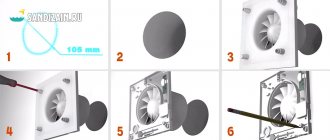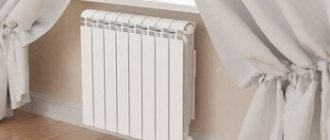The need to heat bathrooms is obvious. At the same time, bathrooms are rooms with specific functionality and special operating conditions, so solving the issue of heating them requires knowledge of the technical characteristics and features of the entire variety of heating devices that are offered to consumers today.
Let's take a closer look at the types of devices suitable for this, and which of them can be used as a heater for a bathroom or bathhouse.
Requirements for bathroom heaters
The operation of bathrooms and baths, due to the purpose of these premises, is characterized by the presence of the following common factors:
- high humidity;
- frequent direct contact of equipment with water and steam;
- compactness of the room.
Based on this, requirements are imposed on bathroom equipment, including heating equipment, non-compliance with which precludes the possibility of operating these units in premises of this type. Let's look at these requirements in more detail.
Safety. High indoor humidity increases the risk of electric shock from contact with electrical equipment if its wiring shorts to the frame. Due to the fact that a person may be naked in the bathroom, the likelihood of injury from electricity in such a situation increases even more. It follows from this that special attention should be paid to the insulation and grounding of electrical equipment, the condition of wiring in bathrooms, and sockets should be installed in a waterproof design.
*
The lack of clothing on a person also increases the risk of burns from body contact with the excessively hot body of the heating device or its heating element. Therefore, heaters in the bathroom should be located in places that exclude contact with the human body, or be equipped with protective covers, or have a safe temperature value for the heat exchanger (case).
Moisture protection. The design of bathroom heating devices must be designed for contact with splashes, steam and high humidity so that the heater does not fail prematurely under the influence of these factors.
In addition, the materials used to make the heating device should not be afraid of water or high air humidity. Heater parts made from materials susceptible to corrosion are coated with a protective paint and varnish composition that is resistant to heat and moisture.
Compactness. Bathrooms are rarely spacious, so bulky heaters are not suitable for them - they take up a lot of space and again increase the risk of getting burned in a cramped room. Therefore, the bathroom heater must be compact and selected for a specific installation location.
Sufficient power. Despite the required compactness of the heating device, the power of the heater should be sufficient for a comfortable stay of a person without clothes and heating the bathroom finishing. The small dimensions of the room simplify this task, however, according to the temperature standards in rooms set out in GOST R 51617-2000 “Housing and communal services”, the temperature in the bathroom should not be lower than 25 degrees, and this is by 5-9 degrees. exceeds the corresponding required indicator for other premises.
Hygiene and aesthetics. A bathroom or bathhouse is a room that has high sanitary and hygienic requirements, so not all types of heaters are suitable for heating these rooms. The use of, for example, liquid fuel heat guns in bathrooms is not permitted due to incomplete combustion of fuel in these devices.
The aesthetics of bathroom heaters should also be at a fairly high level - the psychological state of a person largely depends on this factor, since in this room the residents should be in the mood for relaxation.
For wet areas
We deliver in Moscow to the following areas within the Moscow Ring Road: Academichesky, Alekseevsky, Altufevsky, Arbat, Airport, Babushkinsky, Basmanny, Begovoy, Beskudnikovsky, Bibirevo, Biryulyovo East, Biryulyovo Western, Bogorodskoye, Brateevo, Butyrsky, Veshnyaki, Voikovsky, Eastern Degunino, Eastern Izmailovo, Vykhino, Gagarinsky, Golovinsky, Golyanovo, Danilovsky, Dmitrovsky, Donskoy, Dorogomilovo, Zamoskvorechye, Western Degunino, Zyuzino, Zyablikovo, Ivanovskoye, Izmailovo, Kapotnya, Konkovo, Koptevo, Kotlovka, Krasnoselsky, Krylatskoye, Kuzminki, Kuntsevo, Lefortovo, Lianozovo, Lomonosovsky, Losinoostrovsky, Lyublino, Marfino, Maryina Roshcha, Maryino, Metrogorodok, Meshchansky, Mozhaysky (inside the MKAD), Moskvorechye-Saburovo, Nagatino-Sadovniki, Nagatinsky Zaton, Nagorny, Nizhny Novgorod, Novogireevo, Obruchevsky, Orekhovo-Borisovo Severnoe, Orekhovo -Borisovo Yuzhnoe, Ostankino, Otradnoye, Ochakovo-Matveevskoye, Perovo, Printers, Pokrovskoye-Streshnevo, Preobrazhenskoye, Presnensky, Vernadskogo Avenue, Ramenki, Rostokino, Ryazansky, Savelovsky, Sviblovo, Northern Izmailovo, Northern Medvedkovo, Northern Tushino, Sokol, Sokolinaya Gora , Sokolniki, Strogino, Tagansky, Tverskoy, Tekstilshchiki, Tyoply Stan, Timiryazevsky, Troparevo-Nikulino, Filevsky Park, Fili-Davydkovo, Khamovniki, Khovrino, Khoroshevo-Mnevniki, Khoroshevsky, Cheryomushki, Chertanovo North, Chertanovo Central, Chertanovo South, Shchukino, Yuzhnoye Medvedkovo, Yuzhnoye Tushino, Yuzhnoportovy, Yakimanka, Yaroslavsky, Yasenevo. Delivery cost 300 rub.
We deliver to the following cities in the Moscow region and Moscow districts located outside the Moscow Ring Road: Vnukovskoye, Voronovskoye, Voskresenskoye, Desenovskoye, Kievsky, Klenovskoye, Kokoshkino, Krasnopakhorskoye, Marushkinskoye, Mikhailovo-Yartsevskoye, Moskovsky, Mosrentgen, Novofedorovskoye, Pervomaiskoye, Rogovskoye, Ryazanovskoye, Sosenskoye, Troitsk, Filimonkovskoe, Shchapovskoe, Shcherbinka, Vnukovo, Vostochny, Zhulebino, Kosino-Ukhtomsky, Kryukovo, Kurkino, Left Bank, Matushkino, Mitino, Mozhaisky (beyond the Moscow Ring Road), Molzhaninovsky, Nekrasovka, Novokosino, Novo-Peredelkino, Savelki, Severnoe Butovo, Silino , Solntsevo, Old Kryukovo, Southern Butovo, Aprelevka, Balashikha, Beloozersky, Bronnitsy, Vereya, Vidnoye, Volokolamsk, Voskresensk, Vysokovsk, Golitsyno, Dedovsk, Dzerzhinsky, Dmitrov, Dolgoprudny, Domodedovo, Drezna, Dubna, Yegoryevsk, Zhukovsky, Zaraysk, Zvenigorod , Ivanteevka, Istra, Kashira, Klin, Kolomna, Korolev, Kotelniki, Krasnoarmeysk, Krasnogorsk, Krasnozavodsk, Krasnoznamensk, Kubinka, Kurovskoye, Likino-Dulyovo, Lobnya, Losino-Petrovsky, Lukhovitsy, Lytkarino, Lyubertsy, Mozhaisk, Mytishchi, Naro-Fominsk , Noginsk, Odintsovo, Lakes, Orekhovo-Zuevo, Pavlovsky Posad, Peresvet, Podolsk, Protvino, Pushkino, Pushchino, Ramenskoye, Reutov, Roshal, Ruza, Sergiev Posad, Serpukhov, Solnechnogorsk, Staraya Kupavna, Stupino, Taldom, Fryazino, Khimki, Khotkovo, Chernogolovka, Chekhov, Shatura, Shchelkovo, Elektrogorsk, Elektrostal, Elektrougli, Yakhroma. The cost of delivery to the specified settlements and cities is 400 rubles. at a distance of up to 5 km from the Moscow Ring Road and 300 rubles. + 30 rub. for every kilometer from the Moscow Ring Road. Delivery by transport companies is possible.
We deliver by transport companies to the cities of Russia: Abakan, Abinsk, Aznakaevo, Azov, Aksay, Alapaevsk, Alatyr, Alexandrov, Alekseevka, Aleksin, Alushta, Almetyevsk, Amursk, Anadyr, Anapa, Angarsk, Anzhero-Sudzhensk, Apatity, Apsheronsk, Argun, Arzamas , Armavir, Arsenyev, Artyom, Artyomovsky, Arkhangelsk, Asbest, Astrakhan, Akhtubinsk, Achinsk, Asha, Baksan, Balabanovo, Balakovo, Balakhna, Balashov, Baltiysk, Barabinsk, Barnaul, Bataysk, Bakhchisaray, Bezhetsk, Belaya Kalitva, Belgorod, Belebey, Belovo, Belogorsk, Beloretsk, Belorechensk, Berdsk, Berezniki, Berezovsky, Beslan, Biysk, Birobidzhan, Birsk, Blagoveshchensk, Grateful, Bogdanovich, Bogoroditsk, Bogorodsk, Bologoe, Bolshoi Kamen, Bor, Borzya, Borisoglebsk, Borovichi, Bratsk, Bryansk, Bugulma , Buguruslan, Budennovsk, Buzuluk, Bui, Buynaksk, Buturlinovka, Valuyki, Velikiye Luki, Veliky Novgorod, Veliky Ustyug, Velsk, Verkhniy Ufaley, Verkhnyaya Pyshma, Verkhnyaya Salda, Vichuga, Vladivostok, Vladikavkaz, Vladimir, Volgograd, Volgodonsk, Volzhsk, Volzhsky , Vologda, Volkhov, Volsk, Vorkuta, Voronezh, Votkinsk, Vsevolozhsk, Vyborg, Vyksa, Vyshny Volochyok, Vyazniki, Vyazma, Vyatskie Polyany, Gagarin, Gai, Gatchina, Gelendzhik, Georgievsk, Glazov, Gorno-Altaisk, Gorodets, Goryachy Klyuch, Grozny, Mud, Gubakha, Gubkin, Gubkinsky, Gudermes, Gukovo, Gulkevichi, Guryevsk, Gusev, Gus-Khrustalny, Dagestan Lights, Dalnegorsk, Dalnerechensk, Derbent, Desnogorsk, Dzhankoy, Dzerzhinsk, Divnogorsk, Dimitrovgrad, Dobryanka, Donetsk, Donskoy, Dudinka , Dyurtyuli, Dyatkovo, Evpatoria, Yegoryevsk, Yeysk, Yekaterinburg, Yelabuga, Yelets, Yelizovo, Yemanzhelinsk, Essentuki, Efremov, Zheleznovodsk, Zheleznogorsk, Zheleznogorsk-Ilimsky, Zhigulevsk, Zavodoukovsk, Zavolzhye, Zainsk, Zarechny, Zarinsk, Zelenogorsk, Zelenod Olsk, Zelenokumsk , Zernograd, Zeya, Winter, Zlatoust, Zmeinogorsk, Znamensk, Ivanovo, Izhevsk, Izberbash, Izobilny, Inta, Ipatovo, Irbit, Irkutsk, Isilkul, Iskitim, Ishim, Ishimbay, Yoshkar-Ola, Kazan, Kalach-on-Don, Kaliningrad , Kaluga, Kamenka, Kamensk-Uralsky, Kamensk-Shakhtinsky, Kamen-on-Obi, Kamyshin, Kamyshlov, Kanash, Kandalaksha, Kansk, Karabulak, Karasuk, Karpinsk, Kartaly, Kasimov, Kaspiysk, Kachkanar, Kemerovo, Kerch, Kizilyurt, Kizlyar , Kimovsk, Kimry, Kingisepp, Kinel, Kineshma, Kireevsk, Kirzhach, Kirishi, Kirov, Kirovo-Chepetsk, Kirovsk, Kiselevsk, Kislovodsk, Klintsy, Kovrov, Kogalym, Kolchugino, Komsomolsk-on-Amur, Konakovo, Kondopoga, Kopeisk, Korenovsk , Korkino, Korsakov, Koryazhma, Kostomuksha, Kostroma, Kotlas, Kotovsk, Kokhma, Krasnoarmeysk, Krasnodar, Krasnokamensk, Krasnokamsk, Krasnoperekopsk, Krasnoturinsk, Krasnouralsk, Krasnoufimsk, Krasnoyarsk, Krasny Sulin, Kropotkin, Krymsk, Kstovo, Kuvandyk, Kudrovo, Kudymkar, Kuznetsk, Kuibyshev, Kulebaki, Kumertau, Kungur, Kurgan, Kurganinsk, Kursk, Kurchaloy, Kurchatov, Kushva, Kyzyl, Kyshtym, Labinsk, Labytnangi, Langepas, Leninogorsk, Leninsk-Kuznetsky, Lesnoy, Lesozavodsk, Lesosibirsk, Livny, Lipetsk, Liski, Luga, Lysva, Lyudinovo, Lyantor, Magadan, Magnitogorsk, Maykop, Maisky, Malgobek, Maloyaroslavets, Mariinsk, Marks, Makhachkala, Megion, Mednogorsk, Mezhdurechensk, Meleuz, Miass, Millerovo, Mineralnye Vody, Minusinsk, Mirny, Mikhailovka, Mikhailovsk, Michurinsk , Mozhga, Mozdok, Monchegorsk, Morshansk, Muravlenko, Murmansk, Murom, Mtsensk, Myski, Naberezhnye Chelny, Nadym, Nazarovo, Nazran, Nalchik, Nartkala, Nakhodka, Nevinnomyssk, Neryungri, Neftekamsk, Neftekumsk, Nefteyugansk, Nizhnevartovsk, Nizhnekamsk, Nizhneudinsk, Nizhny Novgorod, Nizhny Tagil, Novoaleksandrovsk, Novoaltaysk, Novovoronezh, Novodvinsk, Novozybkov, Novokubansk, Novokuznetsk, Novokuybyshevsk, Novomoskovsk, Novopavlovsk, Novorossiysk, Novosibirsk, Novotroitsk, Novouralsk, Novocheboksarsk, Novocherkassk, Novoshakhtinsk, Novy Urengoy , Norilsk, Noyabrsk, Nyagan, Obninsk , Ob, Oktyabrsk, Oktyabrsky, Omsk, Orel, Orenburg, Orsk, Osinniki, Ostrogozhsk, Otradny, Pavlovo, Pavlovsk, Partizansk, Penza, Pervouralsk, Pereslavl-Zalessky, Perm, Petrovsk, Petrozavodsk, Petropavlovsk-Kamchatsky, Pechora, Polevskoy, Polysayevo , Pokhvistnevo, Primorsko-Akhtarsk, Prokopyevsk, Prokhladny, Pskov, Pugachev, Pyt-Yakh, Pyatigorsk, Raduzhny, Raichikhinsk, Rasskazovo, Revda, Rezh, Rzhev, Rodniki, Roslavl, Rossosh, Rostov-on-Don, Rostov, Rtishchevo, Rubtsovsk , Ruzaevka, Rybinsk, Ryazan, Saki, Salavat, Salekhard, Salsk, Samara, St. Petersburg, Saransk, Sarapul, Saratov, Sarov, Sasovo, Satka, Safonovo, Sayanogorsk, Sayansk, Svetlograd, Svobodny, Sevastopol, Severodvinsk, Severomorsk, Severouralsk , Seversk, Segezha, Semiluki, Serdobsk, Serov, Sertolovo, Sibay, Simferopol, Skopin, Slavgorod, Slavyansk-on-Kuban, Slantsy, Slobodskoy, Smolensk, Snezhinsk, Sovetsk, Sovetskaya Gavan, Sovetsky, Sokol, Solikamsk, Sol-Iletsk, Sorochinsk, Sosnovoborsk, Sosnovy Bor, Sosnogorsk, Sochi, Spassk-Dalniy, Stavropol, Staraya Russa, Stary Oskol, Sterlitamak, Strezhevoy, Sunzha, Surgut, Sukhoi Log, Syzran, Syktyvkar, Tavda, Taganrog, Taiga, Taishet, Tambov, Tara, Tatarsk, Tver, Teykovo, Temryuk, Timashevsk, Tikhvin, Tikhoretsk, Tobolsk, Tolyatti, Tomsk, Furnaces, Torzhok, Tosno, Trekhgorny, Troitsk, Tuapse, Tuymazy, Tula, Tulun, Tutaev, Tynda, Tyumen, Uvarovo, Uglich, Udomlya, Uzlovaya, Ulan-Ude, Ulyanovsk, Unecha, Urai, Urus-Martan, Uryupinsk, Usinsk, Usolye-Sibirskoye, Ussuriysk, Ust-Dzheguta, Ust-Ilimsk, Ust-Kut, Ust-Labinsk, Ufa, Ukhta, Uchaly, Feodosia, Frolovo, Furmanov, Khabarovsk, Khanty-Mansiysk, Khasavyurt, Kholmsk, Chaikovsky, Chapaevsk, Chebarkul, Cheboksary, Chelyabinsk, Cheremkhovo, Cherepovets, Cherkessk, Chernogorsk, Chernushka, Chernyakhovsk, Chistopol, Chita, Chusovoy, Shadrinsk, Shali, Sharypovo, Shakhty, Shebekino, Shelekhov, Shumerlya, Shuya, Shchekino, Elista, Engels, Yugorsk, Yuzhno-Sakhalinsk, Yuzhnouralsk, Yurga, Yakutsk, Yalta, Yalutorovsk, Yanaul, Yaroslavl, Yartsevo. If your city is not on the list, this does not mean that there is no delivery to it. Contact us at the store.
Types of heating devices for bathrooms
*
Many types of heating devices are used to heat bathrooms and baths. Suitability criterion is compliance with the above requirements and the interior of the premises. Let's look at a few of the most popular heaters.
Electric heated towel rails
These compact devices are autonomous, as they do not depend on water and heat supply systems. The heater consists of a decorative tubular coil in which a heating element is placed, which converts electricity from the household network into heat.
Two types of heated towel rails are produced:
- liquid - a heating element is installed in a sealed tubular housing filled with oil or antifreeze;
- dry (cable) – the heating element in the tube is a self-regulating heating cable.
Installation of these heaters is simple and does not require professional skills - the unit is installed on the wall using standard fasteners included with the device.
Despite their external similarity, these two types of heated towel rail differ in technical characteristics, knowledge of which will facilitate the choice when purchasing a unit.
Liquid heated towel rails
According to the principle of operation and design, this type of heater does not differ from an oil heater - a heating element installed in a sealed housing with oil. The presence of oil, the amount of which must ensure convection of the liquid in the housing, and a more complex safety system, determines the larger dimensions and weight of the liquid unit than that of cable devices. In addition, in order to ensure the tightness of the radiator, the design of the liquid heater is static, that is, it does not contain rotating elements that increase the ease of use of the device when drying things.
Liquid heated towel rails are produced with a power of 0.3 to 0.6 kW, which, if the safety system is working correctly, is enough to heat the surface of the heater to a temperature of 70 degrees - safe for short-term contact with the body and providing a comfortable environment in the room.
Important! Liquid heaters can be connected to the network through a moisture-proof socket or in a hidden way, but they must be grounded - the third grounding conductor in the power cable.
*
Cable heated towel rails
Since the heating element in such devices is a self-regulating electric cable, the requirements for the tightness of the tubular body are not as high as for an oil unit - the body of the cable device must provide protection of the cable only from mechanical damage and moisture, therefore, for convenience, the design of such units includes movable ( rotating) elements.
Cable heaters, which are significantly smaller in weight and dimensions than liquid units, are produced in various configurations, which allows you to choose a device for a specific installation location.
The power of such units, depending on the model, is 60-120 W, which results in low energy consumption. The device heats up quickly and cools down just as quickly, which is not a disadvantage, but a feature of this heater, which is also easy to install and safe to use - there is no need for a grounding device, and the temperature of the body surface does not rise above 65 degrees. The heater is also connected to the network through a socket or in a hidden way.
Heat fan
A fan heater is one of the simplest heating devices, the power of which is in the range of 2-2.5 kW, available in the entire price range and suitable for use in bathrooms.
The unit is a housing in which a blower is installed - a fan that drives room air through electric heating elements. A heater of a higher class can be equipped with a thermostat and a temperature sensor, which control the device’s on/off switching to maintain the desired temperature in the room.
*
Depending on the location of installation, devices are divided into floor, wall and ceiling.
Floor-standing devices are compact and lightweight, have less power, can be moved to any convenient place and directed in the desired direction.
Wall-mounted fan heaters are more powerful electric heaters that have a stationary installation location, but their movable deflectors allow you to change the direction of the flow of warm air in the vertical plane.
Ceiling-mounted heat fans are the most convenient because, in addition to heating the room, they prevent condensation from forming on the ceiling. The sufficiently high power of such devices determines their use in spacious baths and showers, as well as relaxation rooms and dressing rooms of saunas.
Important! For bathrooms, wall-mounted or ceiling-mounted fan heaters are preferred, as floor-mounted ones impede foot traffic and are more susceptible to unwanted direct contact with water.
The heating element in fan heaters can be ceramic, spiral or tubular (TEN).
The most advanced and efficient devices are heat fans with ceramic heaters.
These devices use posistors - semiconductor elements in a ceramic shell, shaped like plates - as converters of electricity into heat. To increase the heat transfer area, the heaters are decorated with a honeycomb heat exchange grid made of aluminum.
The temperature of semiconductor elements does not exceed 150 degrees, which increases the safety of their operation. In addition, posistors have the property of self-regulation - the ability to increase resistance with increasing temperature until conductivity is completely blocked. Thus, as the air in the room heats up, the electricity consumption of such a heater will gradually decrease, which saves not only electricity, but also the automation system.
Naturally, the cost of fan heaters with ceramic heating elements is much higher than heaters with other types of heaters.
Devices with an open heating coil are less preferable when choosing a bathroom heater for the following reasons:
- Accidental contact of a person with a hot spiral is fraught with burns and electrical injury;
- there is a danger of small objects igniting when they come into contact with a hot coil;
- the spiral thread, which heats up to almost 1000 degrees, is in open contact with air and is therefore short-lived;
- prolonged operation of a spiral fan heater worsens the microclimate in the room;
- combustion of dust falling on a hot coil is accompanied by an unpleasant odor.
But the low cost of spiral fan heaters and the ability to carry out repairs on their own contribute to the demand for these devices.
Tubular fan heaters are long-lasting, high-power devices (3-3.5 kW), using the same coil for heating, but placed in a steel tube, smooth or ribbed, filled with quartz sand or manganese oxide - heating element.
In domestic premises, including bathrooms, such powerful heaters are used extremely rarely.
Electric convector
*
This heating device is a closed electric heating element (TEH), installed in a housing with a control system, converting electricity into heat and releasing it to the surrounding air. Heated air rises, giving way to cold air and thereby causing the circulation of convective flows - convection.
In fact, all heating devices that, during operation, transfer heat from their surface to the surrounding air are called convectors - these are water and steam heating radiators, oil heaters, solid and liquid fuel stoves, gas convectors, etc. But in everyday life, only electric heaters with heating elements are called convectors.
For spacious bathrooms and sauna dressing rooms, the best choice from this group of heaters are wall heaters - stationary devices of small thickness, but with a large heat exchange area, protected from tipping over by a rigid attachment to the base.
In small bathrooms you can use portable floor-mounted convectors of low power
The maximum power of convector electric heaters produced for domestic conditions is in the range from 0.5 to 2 kW, which makes it possible to provide comfortable conditions in a bathroom of any size using one or more such devices.
The popularity of using electric convectors in bathrooms is due to the following advantages:
- safety – case temperature no higher than 65 degrees;
- waterproof design;
- ease of installation and daily maintenance;
- possibility of automatic control;
- quiet operation;
- quick access to operating power;
- insignificant negative impact on the microclimate.
The disadvantages of these heaters, like all heaters with heating elements based on a spiral, include high energy consumption - economical posistors are not used in such devices (without a fan) due to the relatively low heat transfer temperature.
The cost range of electric convectors cannot be considered widely accessible - the price of such a device depends on the power, degree of automation equipment and design, while of two devices with the same characteristics, a product from a more well-known manufacturer will be more expensive.
Infrared heaters
Infrared radiation is waves invisible to the human eye, located in the spectrum after red rays. These rays affect the surface of the objects they reach - they excite the movement of molecules to a certain depth, which means they increase the temperature of the physical body, but do not heat the transit medium (air) during passage. Objects heated by infrared rays give off heat to the air and thus increase the temperature in the room.
Heating devices whose operation is based on infrared radiation are called IR heaters.
Depending on the installation site, infrared heaters are produced as floor-mounted, wall-mounted or ceiling-mounted.
Infrared heaters for baths are more convenient in wall and ceiling versions, but it is possible to use floor-mounted IR devices - compact models with a vertical reflector arrangement.
For a bathroom with high ceilings, infrared ceiling-mounted heaters are especially good - such devices are not noticeable even if they are large in size, and their effectiveness does not depend on the distance to the device.
When advertising infrared sauna heaters, manufacturers present these devices as an independent type of heater capable of providing the required temperature conditions. Actually this is not true. The high temperature in the sauna is maintained by other heating equipment, and IR heaters are used in the dressing room and relaxation room in the Finnish bath. In the sauna itself, these devices can only be used when repairing a bathhouse in winter - to ensure technological temperature conditions.
A convenient type of IR heaters for bathrooms are panel electric convectors - moisture-resistant devices of a high class of aesthetics. IR panels are made both colored (plain or imitating natural stone) and combined with mirrors, which hide the true heating function of this element on the wall. The decorative nature of panel infrared heaters for the bathroom determines their high price relative to other IR heaters.
For the bathroom, modern infrared heaters have ceased to be something exotic - the range of varieties produced is so wide, most of which are offered at very reasonable prices.
Selection by parameters
Table for calculating the power of the convector depending on the area of the bathroom.
We have already decided that an electric convector for a bathroom must have a protected housing, protecting equipment from accidental entry of small drops of water and condensation. Let's now decide on other parameters. The first such parameter is the power of the electric convector. For the average bathroom, a 1 kW device is sufficient.
Such a convection heater can heat a bathroom both in a private house and in an apartment. It is not worth taking more powerful units, especially if the area of the room does not exceed several square meters. The exception is large bathrooms, for heating which may require units of increased power - up to 1.5-2 kW.
As for the type of installation, we recommend choosing a wall-mounted model - it will not dangle under your feet, being neatly fixed to the wall. The recommended control is electronic, as this will provide the appropriate level of savings. If you plan to turn on the electric convector only before taking a bath, you can choose a “mechanical” model.
Monolithic electric convectors can also be used to heat a bathroom. Their main advantages:
- Low power is just what is needed for a small room in an average household or apartment;
- Maximum protection from moisture - the heating element is securely hidden in the thickness of a monolithic stone created from quartz sand ;
- They are not afraid of corrosion - the quartz monolith does not react in any way to increased humidity levels.
We also recommend taking a closer look at electric convectors with forced air circulation - they can heat the air in the bathroom in a matter of minutes, which leads to energy savings.
The last option is relevant for those who plan to pump up heat exclusively before taking a shower or bath.











